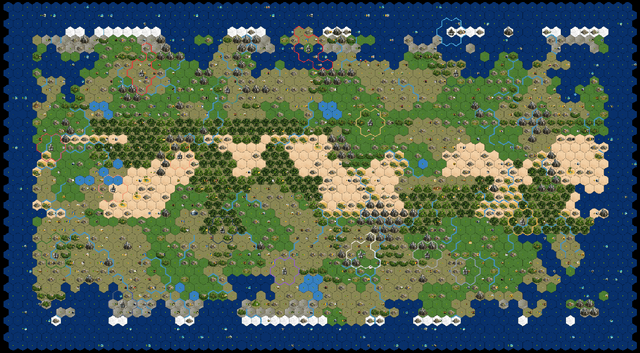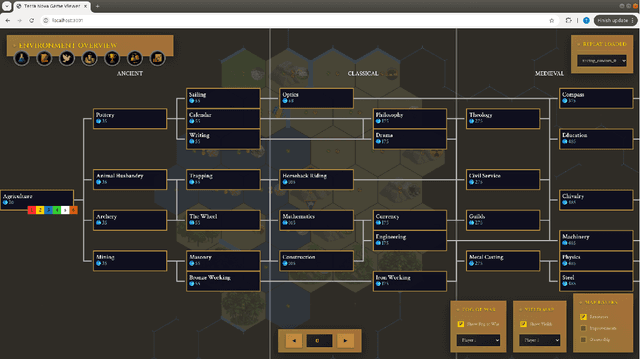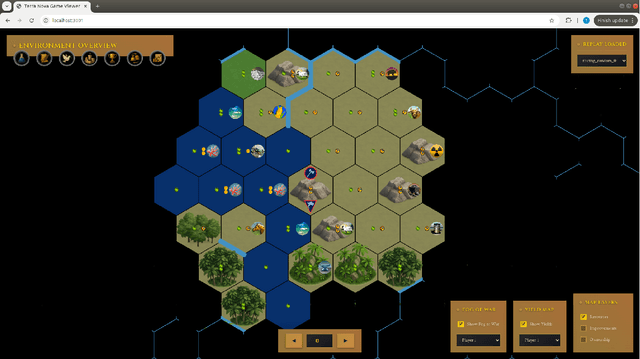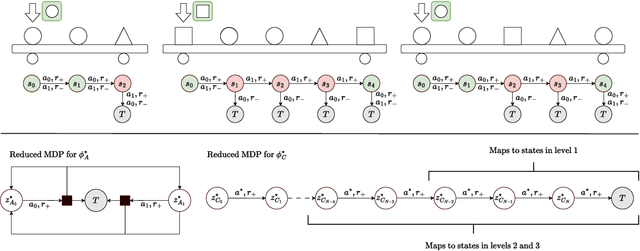Trevor McInroe
Terra Nova: A Comprehensive Challenge Environment for Intelligent Agents
Nov 19, 2025



Abstract:We introduce Terra Nova, a new comprehensive challenge environment (CCE) for reinforcement learning (RL) research inspired by Civilization V. A CCE is a single environment in which multiple canonical RL challenges (e.g., partial observability, credit assignment, representation learning, enormous action spaces, etc.) arise simultaneously. Mastery therefore demands integrated, long-horizon understanding across many interacting variables. We emphasize that this definition excludes challenges that only aggregate unrelated tasks in independent, parallel streams (e.g., learning to play all Atari games at once). These aggregated multitask benchmarks primarily asses whether an agent can catalog and switch among unrelated policies rather than test an agent's ability to perform deep reasoning across many interacting challenges.
Forgetting is Everywhere
Nov 06, 2025Abstract:A fundamental challenge in developing general learning algorithms is their tendency to forget past knowledge when adapting to new data. Addressing this problem requires a principled understanding of forgetting; yet, despite decades of study, no unified definition has emerged that provides insights into the underlying dynamics of learning. We propose an algorithm- and task-agnostic theory that characterises forgetting as a lack of self-consistency in a learner's predictive distribution over future experiences, manifesting as a loss of predictive information. Our theory naturally yields a general measure of an algorithm's propensity to forget. To validate the theory, we design a comprehensive set of experiments that span classification, regression, generative modelling, and reinforcement learning. We empirically demonstrate how forgetting is present across all learning settings and plays a significant role in determining learning efficiency. Together, these results establish a principled understanding of forgetting and lay the foundation for analysing and improving the information retention capabilities of general learning algorithms.
Enhancing Tactile-based Reinforcement Learning for Robotic Control
Oct 24, 2025Abstract:Achieving safe, reliable real-world robotic manipulation requires agents to evolve beyond vision and incorporate tactile sensing to overcome sensory deficits and reliance on idealised state information. Despite its potential, the efficacy of tactile sensing in reinforcement learning (RL) remains inconsistent. We address this by developing self-supervised learning (SSL) methodologies to more effectively harness tactile observations, focusing on a scalable setup of proprioception and sparse binary contacts. We empirically demonstrate that sparse binary tactile signals are critical for dexterity, particularly for interactions that proprioceptive control errors do not register, such as decoupled robot-object motions. Our agents achieve superhuman dexterity in complex contact tasks (ball bouncing and Baoding ball rotation). Furthermore, we find that decoupling the SSL memory from the on-policy memory can improve performance. We release the Robot Tactile Olympiad (RoTO) benchmark to standardise and promote future research in tactile-based manipulation. Project page: https://elle-miller.github.io/tactile_rl
Studying the Interplay Between the Actor and Critic Representations in Reinforcement Learning
Mar 08, 2025



Abstract:Extracting relevant information from a stream of high-dimensional observations is a central challenge for deep reinforcement learning agents. Actor-critic algorithms add further complexity to this challenge, as it is often unclear whether the same information will be relevant to both the actor and the critic. To this end, we here explore the principles that underlie effective representations for the actor and for the critic in on-policy algorithms. We focus our study on understanding whether the actor and critic will benefit from separate, rather than shared, representations. Our primary finding is that when separated, the representations for the actor and critic systematically specialise in extracting different types of information from the environment -- the actor's representation tends to focus on action-relevant information, while the critic's representation specialises in encoding value and dynamics information. We conduct a rigourous empirical study to understand how different representation learning approaches affect the actor and critic's specialisations and their downstream performance, in terms of sample efficiency and generation capabilities. Finally, we discover that a separated critic plays an important role in exploration and data collection during training. Our code, trained models and data are accessible at https://github.com/francelico/deac-rep.
Objects matter: object-centric world models improve reinforcement learning in visually complex environments
Jan 27, 2025Abstract:Deep reinforcement learning has achieved remarkable success in learning control policies from pixels across a wide range of tasks, yet its application remains hindered by low sample efficiency, requiring significantly more environment interactions than humans to reach comparable performance. Model-based reinforcement learning (MBRL) offers a solution by leveraging learnt world models to generate simulated experience, thereby improving sample efficiency. However, in visually complex environments, small or dynamic elements can be critical for decision-making. Yet, traditional MBRL methods in pixel-based environments typically rely on auto-encoding with an $L_2$ loss, which is dominated by large areas and often fails to capture decision-relevant details. To address these limitations, we propose an object-centric MBRL pipeline, which integrates recent advances in computer vision to allow agents to focus on key decision-related elements. Our approach consists of four main steps: (1) annotating key objects related to rewards and goals with segmentation masks, (2) extracting object features using a pre-trained, frozen foundation vision model, (3) incorporating these object features with the raw observations to predict environmental dynamics, and (4) training the policy using imagined trajectories generated by this object-centric world model. Building on the efficient MBRL algorithm STORM, we call this pipeline OC-STORM. We demonstrate OC-STORM's practical value in overcoming the limitations of conventional MBRL approaches on both Atari games and the visually complex game Hollow Knight.
Efficient Offline Reinforcement Learning: The Critic is Critical
Jun 19, 2024Abstract:Recent work has demonstrated both benefits and limitations from using supervised approaches (without temporal-difference learning) for offline reinforcement learning. While off-policy reinforcement learning provides a promising approach for improving performance beyond supervised approaches, we observe that training is often inefficient and unstable due to temporal difference bootstrapping. In this paper we propose a best-of-both approach by first learning the behavior policy and critic with supervised learning, before improving with off-policy reinforcement learning. Specifically, we demonstrate improved efficiency by pre-training with a supervised Monte-Carlo value-error, making use of commonly neglected downstream information from the provided offline trajectories. We find that we are able to more than halve the training time of the considered offline algorithms on standard benchmarks, and surprisingly also achieve greater stability. We further build on the importance of having consistent policy and value functions to propose novel hybrid algorithms, TD3+BC+CQL and EDAC+BC, that regularize both the actor and the critic towards the behavior policy. This helps to more reliably improve on the behavior policy when learning from limited human demonstrations. Code is available at https://github.com/AdamJelley/EfficientOfflineRL
LLM-Personalize: Aligning LLM Planners with Human Preferences via Reinforced Self-Training for Housekeeping Robots
Apr 22, 2024



Abstract:Large language models (LLMs) have shown significant potential for robotics applications, particularly task planning, by harnessing their language comprehension and text generation capabilities. However, in applications such as household robotics, a critical gap remains in the personalization of these models to individual user preferences. We introduce LLM-Personalize, a novel framework with an optimization pipeline designed to personalize LLM planners for household robotics. Our LLM-Personalize framework features an LLM planner that performs iterative planning in multi-room, partially-observable household scenarios, making use of a scene graph constructed with local observations. The generated plan consists of a sequence of high-level actions which are subsequently executed by a controller. Central to our approach is the optimization pipeline, which combines imitation learning and iterative self-training to personalize the LLM planner. In particular, the imitation learning phase performs initial LLM alignment from demonstrations, and bootstraps the model to facilitate effective iterative self-training, which further explores and aligns the model to user preferences. We evaluate LLM-Personalize on Housekeep, a challenging simulated real-world 3D benchmark for household rearrangements, and show that LLM-Personalize achieves more than a 30 percent increase in success rate over existing LLM planners, showcasing significantly improved alignment with human preferences. Project page: https://donggehan.github.io/projectllmpersonalize/.
Planning to Go Out-of-Distribution in Offline-to-Online Reinforcement Learning
Oct 09, 2023



Abstract:Offline pretraining with a static dataset followed by online fine-tuning (offline-to-online, or OtO) is a paradigm that is well matched to a real-world RL deployment process: in few real settings would one deploy an offline policy with no test runs and tuning. In this scenario, we aim to find the best-performing policy within a limited budget of online interactions. Previous work in the OtO setting has focused on correcting for bias introduced by the policy-constraint mechanisms of offline RL algorithms. Such constraints keep the learned policy close to the behavior policy that collected the dataset, but this unnecessarily limits policy performance if the behavior policy is far from optimal. Instead, we forgo policy constraints and frame OtO RL as an exploration problem: we must maximize the benefit of the online data-collection. We study major online RL exploration paradigms, adapting them to work well with the OtO setting. These adapted methods contribute several strong baselines. Also, we introduce an algorithm for planning to go out of distribution (PTGOOD), which targets online exploration in relatively high-reward regions of the state-action space unlikely to be visited by the behavior policy. By leveraging concepts from the Conditional Entropy Bottleneck, PTGOOD encourages data collected online to provide new information relevant to improving the final deployment policy. In that way the limited interaction budget is used effectively. We show that PTGOOD significantly improves agent returns during online fine-tuning and finds the optimal policy in as few as 10k online steps in Walker and in as few as 50k in complex control tasks like Humanoid. Also, we find that PTGOOD avoids the suboptimal policy convergence that many of our baselines exhibit in several environments.
Conditional Mutual Information for Disentangled Representations in Reinforcement Learning
May 23, 2023



Abstract:Reinforcement Learning (RL) environments can produce training data with spurious correlations between features due to the amount of training data or its limited feature coverage. This can lead to RL agents encoding these misleading correlations in their latent representation, preventing the agent from generalising if the correlation changes within the environment or when deployed in the real world. Disentangled representations can improve robustness, but existing disentanglement techniques that minimise mutual information between features require independent features, thus they cannot disentangle correlated features. We propose an auxiliary task for RL algorithms that learns a disentangled representation of high-dimensional observations with correlated features by minimising the conditional mutual information between features in the representation. We demonstrate experimentally, using continuous control tasks, that our approach improves generalisation under correlation shifts, as well as improving the training performance of RL algorithms in the presence of correlated features.
Deep Reinforcement Learning for Multi-Agent Interaction
Aug 02, 2022Abstract:The development of autonomous agents which can interact with other agents to accomplish a given task is a core area of research in artificial intelligence and machine learning. Towards this goal, the Autonomous Agents Research Group develops novel machine learning algorithms for autonomous systems control, with a specific focus on deep reinforcement learning and multi-agent reinforcement learning. Research problems include scalable learning of coordinated agent policies and inter-agent communication; reasoning about the behaviours, goals, and composition of other agents from limited observations; and sample-efficient learning based on intrinsic motivation, curriculum learning, causal inference, and representation learning. This article provides a broad overview of the ongoing research portfolio of the group and discusses open problems for future directions.
 Add to Chrome
Add to Chrome Add to Firefox
Add to Firefox Add to Edge
Add to Edge